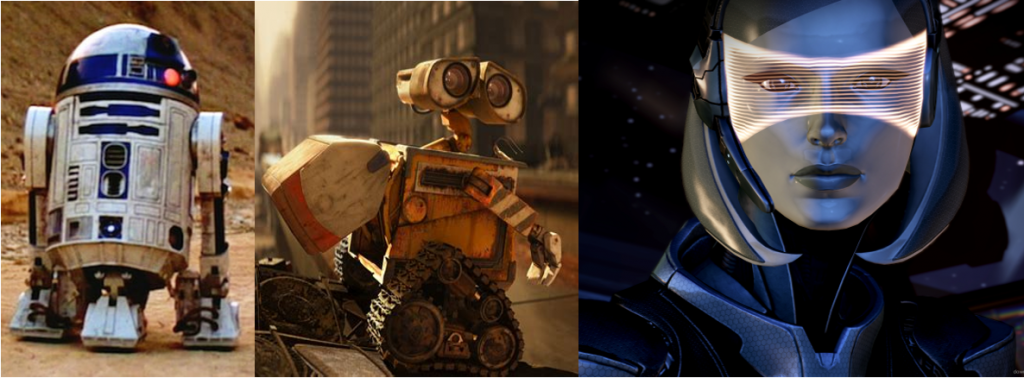Based on my post from last week, I would like to delve further into the topic of robots and Artificial Intelligence. I want to discuss whether robots run by Artificial Intelligence have similar or same level of capacity as humans when it comes to feelings and decision making and whether that is of concern or not.
Difference between robots and Artificial Intelligence
What I would like to clarify from last week is that robots and artificial intelligence (AI) are not the same thing. While robots are surfacing that are powered by AI, various different kinds of robots exist and have done so for a while now. Think for example of vacuum cleaner robots that are immensely popular. Or the drones we’ve gotten used to seeing flying over our heads from time to time.
The robots in question here, are so-called humanoid robots or androids. Like Sophia, who is currently the world’s most advanced human-like robot according to the creators at Hanson Robotics. Curiously enough, robots as purely a machine with no human-like features and a robot that is meant to resemble humans seem to be thought of almost interchangeably. To the extent that the Merriam-Webster dictionary even includes it in their main definition of the word robot that it is often built to resemble humans (or animals), as can be seen by the definition given here below:
robot noun:
a machine that resembles a living creature in being capable of moving independently (as by walking or rolling on wheels) and performing complex actions (such as grasping and moving objects)often : such a machine built to resemble a human being or animal in appearance and behavior
Merriam-Webster. (n.d.). Robot. In Dictionary by Merriam-Webster. Retreived September 27, 2021, from https://www.merriam-webster.com/dictionary/robot
As can be seen from the definition, the understanding of the purpose of robots is purely practical. They are built to make human lives easier, oftentimes to help with mundane and repetitive tasks such as vaccuming. In the case of the human-like robot Sophia. The purpose of Sophia is to develope understanding in various fields, such as medicine, education and science research, to help and assist in those fields. She represents a collective intelligence as a combination of human and artificial intelligence. Sophia’s ability to store a great amount of data (compared to memories), allows her to be more reliable when it comes to retreiving the data and using it. While she can mimick human emotions, the creators of her stress that the emotions are meant for easier communication between human and machine. With Sophia being able to convey emotions, albeit unlikely feeling them herself, it makes her increasingly more relatable and clearer to communicate with.

Dystopia or Utopia?
But if robots are purely built for practical purpose and in cases only meant to resemble humans without becoming one, how come that human like robots are being given citizenship and the discussion for their rights is a hot topic? Perhaps the question is not so much about whether robots should get rights but rahter whether Artificial Intelligence (AI) in the forms of robots should earn that right.
In his short but sharp article from 2015, author Hutan Ashrafian touches upon the rapid growth of AI powered robots around the globe. Probably not knowing that only a year later the robot Sophia would be activated and two years later become the first robot citizen. In the article, Ashrafian voices a concern that may be familiar to readers. That is the importance of robots, more specifically robots powered by AI resembling human intelligence, must respect and protect humans at all cost and not turn against them. Although he voices a concern that many may share, the fear of robots and AI turning against humans stems mostly, if not purely, from science fiction. That AIs deviate from the (human) language they are initially taught, and develope a language of their own to communicate with each other is not unknown as examples show. However, it is important to take into account that robots and AI is built, developed and controlled by humans. Making it difficult or even impossible for machine to attempt to take over the world. As it still stands, there is no robot known of that has a consciousness of its own and can fully operate independently. Not even Sophia, the humanoid robot, as most of her public appearances and interviews are partly scripted by the makers.
That being said, there are activists surfacing that want to ensure that robots will enjoy the same rights as humans as they surpass us in intelligence, according to them. According to an article on the UK news website Metro, the Transhumanist party in the United States wants to “[…] give rights to a range of ‘sentient entities’, many of which have not come into being yet.”. Therefore protecting the rights of a range of digital intelligences.
Those two opposing views are on the opposite end of the stick when it comes to radical views regarding Artificial Intelligence. Either it takes the dystopian view of technology becoming dangerous to humans if we are not careful or the utopian view of living together with machines that are practically human. If we take a step back and think about how much technology in general has advanced in the last 50-100 years, it is probably safe to say that the digital society we live in today was probably seen as an imminent danger to human kind for some at the time.
I’d like to propose not to look at how technological developments will harm humans but how they will help us. Most devices, robots included, that we use on daily basis, were originally designed with the purpose of improving our lives. Therefore, the human agent will always be the largest part of technology and machines, no matter in what form, will have the aim to assist humans and improve human lives – not vice versa.
Further reading:
Moerland, T.M., Broekens, J. & Jonker, C.M. Emotion in reinforcement learning agents and robots: a survey. Mach Learn 107, 443–480 (2018). https://doi-org.ezproxy.leidenuniv.nl/10.1007/s10994-017-5666-0



Recent Comments